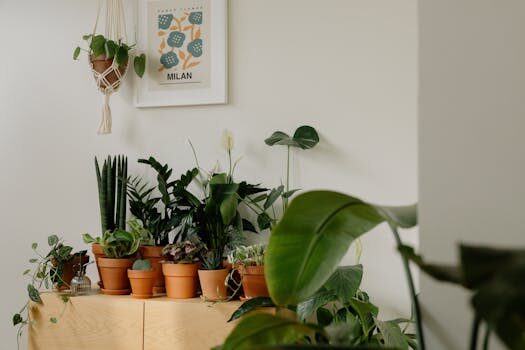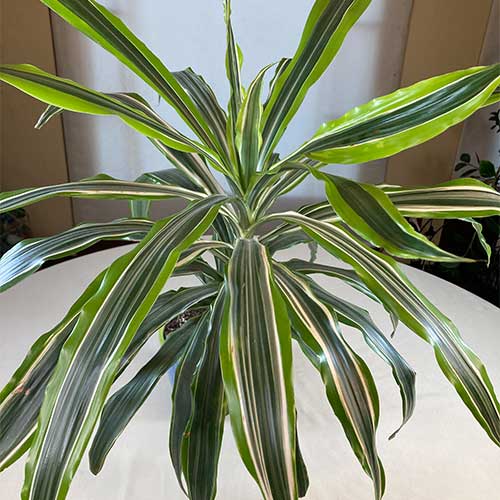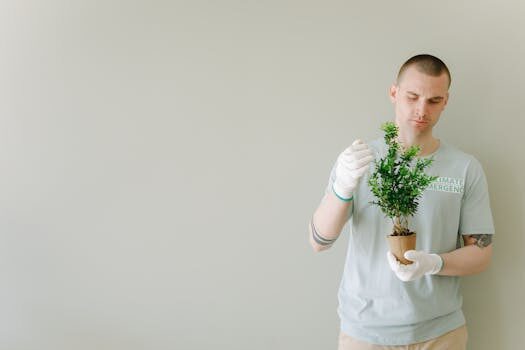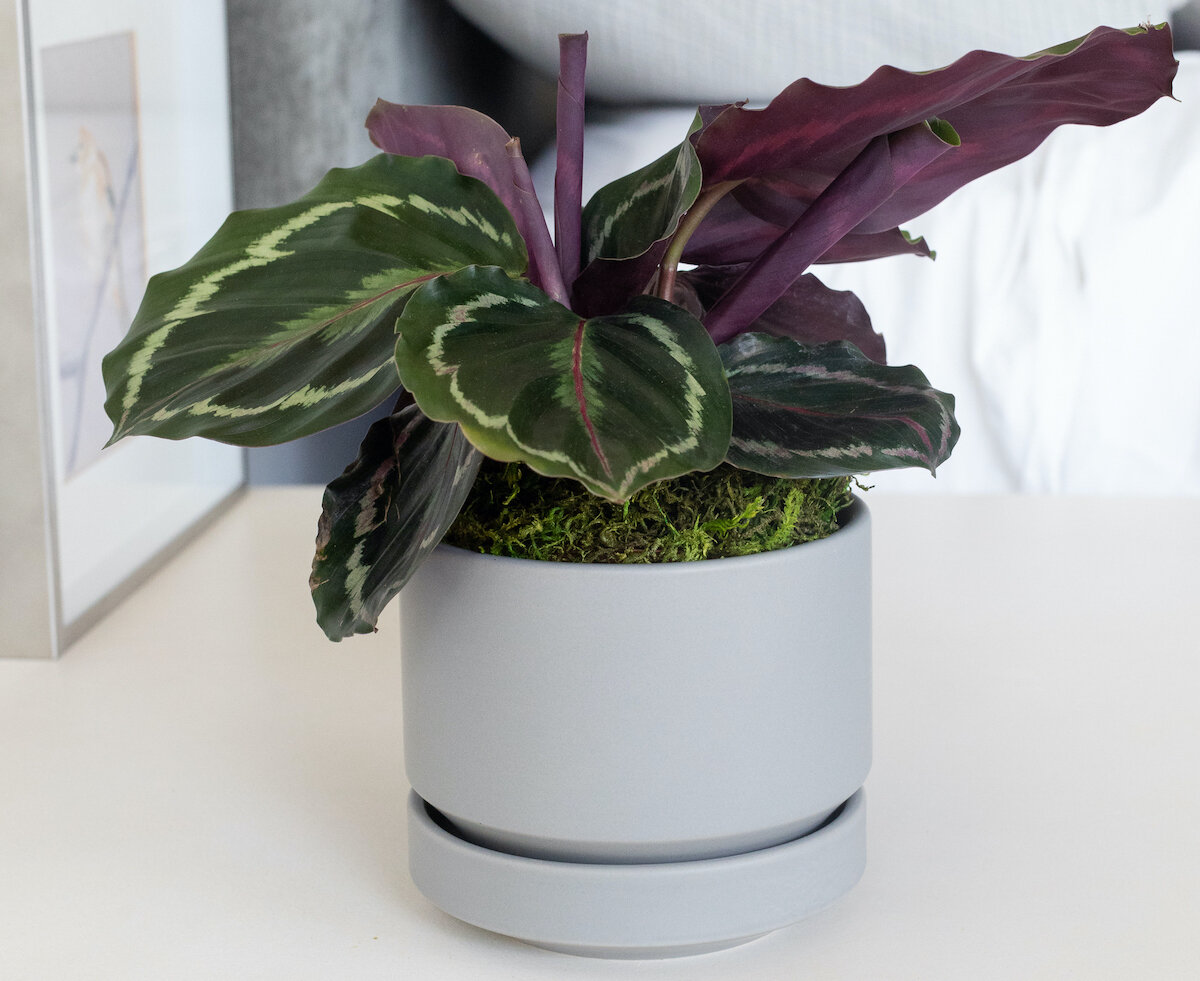Calathea plants, with their lush foliage and intricate patterns, have become a staple in the homes of plant enthusiasts. Their ability to thrive indoors with the right care makes them a popular choice for home gardens.
How to care for your Calathea plant?
Calatheas are tropical plants that flourish in environments similar to their native jungle habitats. Keep the soil consistently moist but not waterlogged to mimic these conditions. Filtered or rainwater is best as they are sensitive to fluoride and other chemicals in tap water. Calatheas prefer medium to low light; too much direct sunlight can bleach their beautiful leaves. Humidity is crucial; aim for 60% or higher. A humidity tray or room humidifier can help achieve this.
Temperature consistency is also important; keep your Calathea away from sudden temperature changes and cold drafts. Optimal temperatures are generally between 16-24°C (60-75°F).
Lastly, fertilize every month during the growing season with a diluted, balanced fertilizer. Regular feeding supports their vibrant foliage.
What are the common problems with Calathea plants?
One of the most common issues is leaf discoloration, often caused by improper watering or exposure to direct sunlight. Calathea leaves turning brown is a sign of either under-watering or exposure to chemicals in tap water.
Pests such as spider mites and mealybugs can also be troublesome. Regularly inspect your plant and treat it with neem oil or insecticidal soap if needed.
Another problem can be a lack of humidity, leading to crispy leaves. Employ misting, humidifiers, or pebble trays to maintain the right environment.
How to save a dying Calathea plant?
If your Calathea is looking less than lively, assess the watering schedule first. Overwatering can lead to root rot, while underwatering can dehydrate it. Ensure proper drainage and adjust your watering as necessary.

Check for pests; these can cause significant stress to the plant. Treat infestations promptly with appropriate measures.
Examine the light conditions. Too much direct sunlight can scorch leaves, while too little can cause leggy growth.
Finally, evaluate the humidity and temperature. If either is too low, take steps to increase them to create an ideal environment for Calathea growth.
What are the benefits of Calathea indoor plants?
Calatheas are known for their air-purifying qualities, capable of removing toxins from indoor air. Their vibrant leaves also have a calming effect, enhancing the aesthetic of any room.
Being non-toxic, they are safe for households with pets and children. Calathea’s daily leaf movements provide an added intrigue, with leaves folding up at night and spreading out during the day.
Additionally, their diverse varieties add a unique flair to indoor plant collections, making them fantastic conversation starters.
What are the different types of Calathea varieties?
There are over 600 species within the Calathea genus, each with its own distinct leaf pattern and coloration. Popular varieties include:

- Calathea Orbifolia: Known for its large, round, striped leaves.
- Calathea Medallion: Features leaves with a feathered pattern in green and purple hues.
- Calathea Rattlesnake: Recognized by its elongated leaves with wavy edges and dark spots.
- Calathea White Fusion: Prized for its variegated leaves of white, green, and hints of purple.
Each variety brings its own unique beauty, but all require similar care to thrive indoors.
 Dracaena care and growing guide: how to grow a dragon tree
Dracaena care and growing guide: how to grow a dragon treeHow to propagate Calathea plants successfully?
Propagation of Calathea plants is typically done through division. Divide the plant during repotting, ensuring that each section has a part of the root system.
Propagate in the early spring before the growing season starts. Use a sharp, clean knife to minimize stress to the plant.
After division, pot each new plant in a similar soil mix to the parent plant and maintain a high humidity level to encourage root growth.
Be patient, as Calathea can be slow to establish new growth after propagation.
Where is the best place to put a Calathea plant?
A Calathea plant thrives in a spot with bright, indirect light. They do well in rooms with east or north-facing windows or shaded south or west-facing windows.
Avoid placing your Calathea near air vents, as drafts can cause stress. Bathrooms with frosted windows can be ideal due to their higher humidity levels.

Remember that Calathea’s leaves will move and adjust throughout the day, so they need some space to display their natural behavior.
Frequently asked questions about Calathea care
Where is the best place to put a Calathea plant?
Calatheas perform best in bright, indirect light with high humidity, away from drafts. A spot near a north-facing window or a shaded area of a room is ideal. Bathrooms can be a great location due to the higher humidity levels.
These plants are sensitive to direct sunlight, so ensure they are placed where soft, filtered light can reach them without causing leaf burn.
Should you cut brown leaves off a Calathea?
Yes, removing brown or damaged leaves from your Calathea helps the plant direct its energy to new, healthy growth. Use clean, sharp scissors or pruning shears and cut back the affected leaves to the base of the stem.
Regular pruning also helps maintain the plant’s shape and encourages a fuller, bushier appearance.
How to make a Calathea happy?
For a happy Calathea, maintain consistent soil moisture without waterlogging the roots. Provide them with medium to low light and protect them from direct sunlight. Keep the humidity high, above 60%, and use room temperature water to avoid shocking the plant.
Feed it with a balanced, diluted fertilizer monthly during the growing season and ensure temperatures remain between 16-24°C (60-75°F).

What is a common problem with Calathea?
One common issue is leaf browning, which can be due to inconsistent watering, low humidity, or exposure to chemicals in tap water. Pests such as spider mites can also pose a problem. Monitor your plant’s environment closely and adjust care as needed.
Remember to use filtered water and keep the plant in a high-humidity location away from direct sunlight and drafts.
Incorporating a relevant video can provide visual guidance on Calathea plant care.
 Why is my orchid dying? The experts explain what not to do when caring for these exotic plants
Why is my orchid dying? The experts explain what not to do when caring for these exotic plantsCalatheas are truly fascinating houseplants that, with the right care, can be a joy to any indoor gardener. By understanding and replicating their natural habitat’s conditions, you can enjoy the dynamic beauty and air-purifying benefits of these stunning plants.

